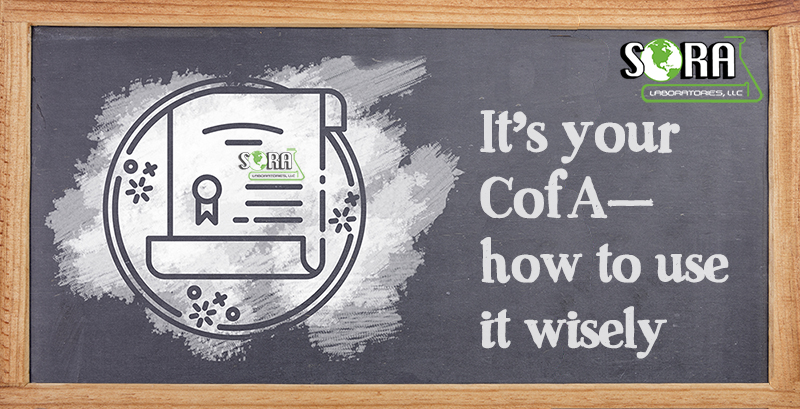Lab testing to verify identity, potency and strength of supplement ingredients/blends is a normal part of the quality control process. Because of this, a manufacturer’s quality control department should be well-versed in many regulations that need to be followed to manufacture a quality product. One of these regulations is allergen labeling. The Food Allergen Labeling and Consumer Protection Act (FALCPA) requires that the label of a food that contains an ingredient that is or contains protein from a “major food allergen” declare the presence of the allergen in the manner described by the law. FALCPA identifies eight foods or food groups as the major food allergens. They are milk, eggs, fish (e.g., bass, flounder, cod), Crustacean shellfish (e.g., crab, lobster, shrimp), tree nuts (e.g., almonds, walnuts, pecans), peanuts, wheat, and soybeans1.
While the FDA doesn’t have specific limits for the “Big 8” allergens, it has determined specifications for gluten. In 2014, the FDA defined the term “gluten-free” for voluntary use in labeling of foods. If gluten is quantified at less than 20 ppm then the product can be labeled as “gluten-free”2.
To meet regulations for identifying allergens or to claim a product is “free” of an allergen, testing must be completed by an accredited lab, such as SORA Labs. Most allergen testing can be completed by using ELISA (enzyme-linked immunosorbent assay) kits or HPLC (high performance liquid chromatography) methods. SORA Labs uses ELISA kits as a first step to accurate allergen testing (link to allergen flyer). ELISA kits have established limits of detection (LOD) and limits of quantitation (LOQ). If the results are below the LOD or LOQ of the kit, then the presence of the allergen is considered below the detectible level and is reported <LOQ or <LOD. If the result is above these limits, then a quantifiable number will be reported.
Since the FDA does not have specifications established for the other allergens, companies are responsible for deciding how to manage the allergen information and labeling of products that could contain those allergens. One useful resource is the Allergen Bureau, which was established to help the food industry in New Zealand and Australia with common allergen information and risk. The Allergen Bureau created the VITAL (Voluntary Incidental Trace Allergen Labeling) Program (The VITAL Program is a standardized risk-assessment program for the food industry, and can be utilized as a resource for companies needing ingredient allergen information, cross-contact data, as well as other information on labeling guidelines.
The bottom line is that there is a lot to consider when labeling your products, when considering allergen-related concerns. SORA Labs can help—we are experienced in allergen identification and testing and can help you get the data you need to label your products accurately. SORA Labs wants to be your partner in quality! Call us today!
Skip the Headache—Let SORA Labs Take the Stress out of Probiotic Testing
Testing is a key component for properly manufacturing and labeling quality products, even more so for probiotic products. In working with probiotic ingredients the testing is more critical because probiotics are extremely sensitive to heat and humidity. Ensuring quality products requires accurate and consistent testing.
Probiotic enumeration (the process of verifying the number of live colony-forming units or CFUs), like many microbiology methods, includes procedures for diluting the sample so the final dilution plate is in a readable range of 25-250 colonies. Since most probiotic formulas have specifications in the millions or billions of cfu/g, the only way to verify these large counts is to have microbiology plates that are diluted to 10-9, 10-10 or higher.
Testing should always start with verifying the raw material potency, then checking the blend uniformity and finally, ensuring the finished product meets label claims. If the product is going to be labeled with an expiration date, then one additional step is required— shelf-life verification or stability testing.
Stability testing is vital for probiotic products because they can lose potency more quickly than other dietary supplement ingredients, due to the sensitive nature of the bacteria. Probiotic activity, measured in colony forming units (CFU), declines when exposed to heat and humidity, therefore special handling and storage is required to preserve the activity. As raw materials or finished products age, periodic verification of the potency is necessary. This is a few of the reasons stability testing is so important for probiotic products.
The goal with stability testing is to ensure the full label claim is met all the way through the expiration date. Often, overages in the formulation are needed to account for the normal loss of good bacteria over time. Testing at periodic intervals, such as every three to six months will provide the data needed to label the expiration date with assurance. There are guidelines available to plan your stability study and SORA Labs can help execute that plan with ease. Don’t let probiotic viability become a headache—let us quote your project today!
News Release: SORA Lab Employees Enjoy Day of Appreciation

 Forsyth, Missouri—In a busy lab, it can be difficult to take a moment to enjoy the results of hard work and dedication, but SORA Labs knows the value of their amazing team and spent Thursday, March 1 showing them how much they are appreciated.
Forsyth, Missouri—In a busy lab, it can be difficult to take a moment to enjoy the results of hard work and dedication, but SORA Labs knows the value of their amazing team and spent Thursday, March 1 showing them how much they are appreciated.
Taking a break from their busy testing schedules, they spent the afternoon tasting delicious chili concoctions in the employee chili-cookoff. Employees were also treated to a luncheon served by leadership in the spirit of thanks. A beautiful day was enjoyed with food and fun, by the entire team.
“Our employees are the backbone of SORA Labs,” said Tammy Blakemore, general manager-SORA Labs. “They allow us to provide accurate, quality service with the highest level of integrity, and they serve in their individual roles with a daily passion that shows in the quality of our testing services.”
____________________________________________________________________________________
SORA Labs is a full-service analytical, microbiological, and physical testing laboratory. For more than 20 years they have dedicated themselves to perfecting methodologies, performing analytical tests and developing procedures to be a one-of-a-kind testing facility. Their testing is compliant with FDA cGMP regulations for the dietary supplement industry, and their capabilities span vitamins, minerals, nutraceuticals, botanical ingredients and more. Specializing in enzyme assays, they are the foremost experts in testing for quality and potency in natural ingredient raw material and finished products.
Knowledge is power—testing is a worthy investment
When working with ingredients that typically measure potency with weight, i.e. mg, it can be difficult to understand the complexity of potency measured in “activity units.” Enzyme activity quantifies the amount of work the enzyme is doing. In the digestive process, we eat food and enzymes break the chemical bonds of the food substances creating a chemical reaction that can be measured– take a look!
Enzyme activity is not just listing the weight of the enzyme in the product, in fact it shows that the enzyme is active and is able to break down the food we consume—this is powerful information to have. Vitamins and minerals are labeled using mg as the potency value, but with enzymes, listing weight only shows that it is included in the product. It does not show the most important attribute—not only is the enzyme in the product, but it’s active and able to do work!
To measure the specific chemical reaction of enzymes, methods are set-up under very controlled conditions. Many of these methods come from the USP/FCC, British Pharmacopeia, Japanese Pharmacopeia, etc. These methods all have procedures for controlling the exact temperature, pH, time of the reaction and how results are calculated. There are also specific substrates (food to be broken down) for each method, so the reaction can be reproduced and different samples can be easily compared. This is ideal for comparing enzyme sample A to enzyme sample B. Moreover, it’s easy to see which raw material shows more activity, is more potent or if your finished product meets label claim.
Enzymes are categorized in groups depending on which bonds the enzyme can break, and there are different enzyme activity units because there are a variety of enzyme reactions that can be measured. Proteases break down proteins; lipases break down fats/lipids; lactase breaks down lactose; and amylase breaks down carbohydrates/starch, etc.
Each category is represented by different activity units. Proteases can be measured in HUT activity when measuring the reaction of breaking down hemoglobin. SAP activity for proteases is determined when showing the breakdown of casein at pH 3.0. Protease FCC PU activity can be measured when wanting to see the breakdown of casein in neutral pH 7.0. While these are just a few examples of how to measure protease activity, the resulting knowledge about multiple protease substrates and the optimal pH range is worth the testing investment that could pay off when marketing the finished product.
Thinking about potency in terms of “activity units” can be confusing, but testing gives you confidence, knowing that you are starting with a fully potent, raw material that is capable of producing a finished product that meets label claims. SORA Labs is your trusted partner when helping you navigate these complex test methods. Contact us for an enzyme testing quote today!
SORA Labs January 2018 Newsletter
Calculating Label Claims
Formulate
You have formulated your product, now what? Take a look at the formula specification sheet to determine what raw materials are needed.
Test Raws
Every raw material going into a formula needs to be tested (CFR Title 21 part 111.75). Once tested, a raw materials certificate of analysis will be received.
Build Label
With the specification sheet and raw material certificate of analysis in hand, the label claims are ready to be made. Download our calculator to assist in building the label.
How To Use The Calculator
Here are the steps to help populate the calculator:
- Enter the raw materials in column A
- For columns D & E use the formulation specification sheet to find the correct information
- Activity claim and activity units for columns B & C can be found on the raw material certificate of analysis or specification sheet
- Columns G & H are the target specifications for the finished product. This information is used to create the label and is also what you include on the sample submission form for testing the finished product
CRN Member Spotlight
Substantiating label claims can be a daunting process, but testing is always a good place to start. Knowing exactly what is in the supplement bottle is paramount, and recent FDA warning letters confirm this. FDA requires that products have specifications and that those specifications are met. Following 21 CFR part 111 for dietary supplement products, the rules make it clear that testing is required.
Check the article on CRN’s Website
Simple question—complicated answer
Question: Can you test the potency of my multi-strain probiotic blend? Answer: Yes. And, while this is a commonly-asked question we find very easy to answer, the process for testing probiotic blends isn’t so simple.
Since testing probiotic blends is complicated, we recommend testing potency by plate count methods that report in Colony Forming Units or CFU/g. Labeling and testing in CFU/g, instead of mg or weight, is the best and most accurate way to verify the potency of probiotics. These methods account for the live bacteria in the product, which measuring by mg or weight does not. Labeling the product by weight will not ensure the specific attributes for the health benefit that is intended.
In early 2017, CRN and IPA released the Probiotics Best Practices Guidelines. These voluntary guidelines outline labeling, stability testing and storage recommendations for probiotic products. These best practices are intended to create consistency with products and transparency across the industry, and they also clearly recommend the CFU/g labeling for potency claims of probiotics.
It is commonly understood that testing probiotics is challenging. That is why we work with raw material manufacturers to be proficient with their methods for their specific probiotic strains. The Food Chemical Codex (FCC) has included some probiotic methods in their compendia, helping to improve method standardization. For a lab like ours, this means we are required to keep multiple medias and agars on hand for the samples sent to us for testing. And although so many different methods are requested, rest assured that we keep the lab supplied and ready for your samples!
Unfortunately, the methods for enumeration are developed for raw materials and are not usually designed for probiotic blends. Once the strains have been blended together, they become like scrambled eggs and cannot be enumerated separately. When running one CFU/g method for the blend, the goal is to show the full combined potency. When testing a blended product, we will look at it as a whole to determine which single method may be best to quantify multiple probiotics in the formula. Since each method uses a specific agar and media for best growth of that strain, not every strain may grow on every media. We also look at co-ingredients, such as botanicals or other non-probiotic ingredients, that could affect the testing and create an interference. Once we have completed the initial evaluation to determine the best method that can potentially enumerate the most strains, we can move forward with product testing. If interferences or testing issues arise, then additional method development work may be required.
Probiotics are usually very high-count materials, and this can be a concern in a clean microbiology lab environment. Precautions should be taken with lab design, sample segregation, extra cleaning and air handling to prevent possible cross-contamination with clean or bacteria-free samples housed in the lab.
It’s important to realize that not all labs are designed or are even able to perform these complex methods—choose your testing lab carefully. SORA Labs is highly experienced and can provide accurate testing for all your probiotic products. Make the obvious choice today!
It’s your CofA—how to use it wisely
Testing to ensure product and ingredient quality is a very important step in maintaining the integrity and efficacy of your brand. Because of FDA and regulatory pressures, verification testing is always top of mind. But testing also represents an investment in your product quality. Have you ever considered how you can use testing result data to drive sales and build your company’s brand?
A non-modified Certificate of Analysis (CofA) from SORA Labs can be used in its entirety on your website or within your marketing material without any additional permission from us—it’s your purchase to utilize for this purpose. If you do choose to modify the CofA or only use parts of it, we require a quick marketing agreement that allows us to approve the modifications. We believe that your product testing investment is a quality-minded attribute that should be advertised and used to promote your brand.
Some ways to get the most out of your CofA can include highlighting testing results that demonstrate the quality of your ingredients or products. If you show a CofA for aflatoxin, allergens, micro pathogens, or pesticide residue that are below the level of detection, this can instill customer confidence that your products are free from harmful substances and are safe to consume. Showing results for botanical identity or active ingredient potency also lets consumers know they are getting the quality of ingredients they see on the label and have come to expect. Additionally, tracking assays over time can be graphed/visually represented to show the ongoing shelf life and stability of your finished product.
SORA Labs wants to give you tools, such as solid testing data, to help you sell your products with confidence. Product testing can give you much needed data and fact-based information to help set your products apart from the rest. So, how can you use your CofA to create a more successful selling strategy? Use it to elevate your product quality in the minds of consumers and successfully build your brand!
Setting the pace—we make it easy to keep up
The supplement industry tends to create complex, multi-ingredient blends in a complicated matrix. Developing a standard product matrix and validating methods therein, can be a time-consuming, costly process. Although the standard capsule or tablet form is most common, stick pack blended powders, liquids, gummies, soft chews and even supplemented food products have made their way into the market successfully. But, have you ever thought about how standard methods were modified to accurately test these new products? As dietary supplement sales continue to increase year over year, they will often out-pace science and method development. SORA Labs has the expertise and resources to successfully develop a testing process to fit your new product matrix.
Since the standard testing methods are often designed for single ingredient raw materials or simple finished products, these blended products are often challenging to test accurately. Probiotics are a great example, as they are often included in complex, sugar and acidic flavored mixtures like gummies or soft chews. These samples can sometimes change the starting sample solution pH, and method development may be needed to determine if this pH variation will affect the method or if a pH adjustment needs to be considered before the testing begins. When a method is modified, validation steps need to be completed to ensure the method still performs as designed. Each step can be addressed and discussed to achieve the most accurate results for your matrix sample.
Enzyme blends in a sugar or soft chew type matrix, are another relevant example. When performing a standard enzyme activity method, the first step is placing the sample into the solution, dissolving a gummy, sugary mixture can become perplexing. Finding the best way to dissolve the matrix completely without destroying the enzyme itself, can also be a challenge. Since enzymes deactivate with heat, warming the solution is not a valid option. SORA Labs works with these sample types routinely, determining the optimum sample prep that allows the enzymes to act on the substrate and create the reaction needed to measure the activity, is key for a successful and accurate result. Experience with difficult assays and complex matrixes is one of our specialties, and SORA Labs is here to help with method development and probiotic and enzyme blend testing! Call us today to take the headache out of this complex testing process.
Making sure your organic ingredients are “actually” organic—a guide to testing
To be labeled organic, foods and botanicals must be certified as such by the USDA. Since there are strict standards in place for growing and processing these ingredients, many fertilizers, insecticides, herbicides and fungicides in conventional farming are prohibited in organic production. This even includes pre-treated fungicides on seeds.1 With so many restrictions in place for organic labeling, organic/non-toxic fungicides are being used, although sometimes proving ineffective in killing fungi. With this in mind, how can a manufacturer or brand mitigate their risk when purchasing and using ingredients that are labeled organic? The answer resides in testing.
Since organic/non-toxic fungicides are being used, it is imperative to ensure that these fungicides are actually effective in preventing mycotoxins formation. Mycotoxins are secondary metabolites produced by microfungi that are capable of causing disease and illness.2 Research shows that aflatoxin is the most common mycotoxin found in spices and herbs.3 Aflatoxins are produced from fungi that hasn’t been properly controlled. This leads to toxins being present in grains, nuts, herbs or other susceptible plants, calling for careful screening of aflatoxins when using botanical ingredients in products. Screening can be done with a general ELISA aflatoxin kit that measures total aflatoxin levels and gives an indication of toxins present in the material. There are also specific tests by HPLC or HPLC-MS technology which give exact levels of B1, B2, G1, G2 or other toxins. Most often, general screening is completed on incoming botanical materials to see if aflatoxin is present, and then follow-up testing is ordered to determine the specific levels of each toxin.
Since organic fertilizers can introduce harmful bacteria to the foods or botanicals being grown, monitoring the bacteria contamination with stringent microbiology testing, is necessary. Testing botanical ingredients for total plate count, coliform, Escherichia coli, yeast, mold and salmonella is a good place to start. These counts will give you valuable information about the cleanliness of the organic herbal when it arrives at your facility. Since microbiology contamination can happen anytime throughout the manufacturing process, additional microbiology testing needs to be completed before final release to the market.
Since the farming techniques for organics do not allow for commercial pesticides, run-off and contamination from other farms should be considered. And while there are many other tests to consider for organic ingredients, screening for pesticide residue is a good idea to ensure contamination has not happened.
Botanical ingredients introduce a level of complexity not previously experienced when using other ingredients in nutritional products and working with those labeled organic, poses additional challenges. Determining the needed testing can be complicated (Botanical Blog) but SORA Labs can help you determine the appropriate testing services needed for each ingredient. Don’t stress—let us help you with your testing needs today!
- Guide for Organic Crop Producers, pg. 7. ams.usda.gov/nop
- Bennett, J. W., and M. Klich. “Mycotoxins.” Clinical Microbiology Reviews3 (2003): 497–516. PMC. Web. 31 July 2017. https://www.ncbi.nlm.nih.gov/pmc/articles/PMC164220/
- The Scientific World Journal, Volume 2013 Article ID 874093.
http://dx.doi.org/10.1155/2013/874093










